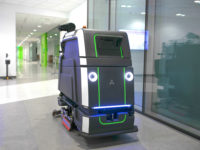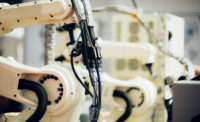Everyone has heard of the term “smart factory” by now, but what is it exactly, and how is it being implemented right now? The smart factory is a highly digitized manufacturing facility that continuously collects and shares data through connected machines, devices, and production systems. The data can then be used by self-optimizing devices or across the organization to proactively address issues, improve manufacturing processes and respond to new demands.
Various technologies such as Artificial Intelligence, Big Data Analytics, Cloud Computing, and Industrial IoT (Internet of Things) have made smart manufacturing possible.
By connecting the digital world with human employees and practices, smart factories can monitor the entire production process, from manufacturing tools and the supply chain to individual operators on the shop floor. When implemented, smart factories would use fully-integrated, collaborative manufacturing systems to make operations flexible, adaptable, and optimizable.
Manufacturing trends
Both the immediate and long-term future of the manufacturing industry will be defined by the development of several ever-evolving and cutting-edge trends and technologies. Many of these trends and technologies are likely to have a significant impact in 2020 and beyond.
The Association of Equipment Manufacturers says: “It’s critically important for manufacturers to develop a keen understanding of what they are, how they will grow over time, and how they will impact those within the industry – both this year and in the future.”
Smart factories are already becoming the norm in manufacturing, and they rely on connected devices to leverage technologies like automation, artificial intelligence, IoT and more. In addition, these devices are capable of sensing their environments and interacting with one another. As factories of the future continue to grow and develop, manufacturers need to realize that they must be able to adapt the networks that connect them – efficiently and effectively. These factories will rely much more on sensor technology, and they will prominently feature connected tools, utilizing data to guide the tasks of the workforce.
Industry 4.0
The manufacturing practice adopted by smart factories is the most optimized application of technologies arising from the fourth industrial revolution known as Industry 4.0. Smart factory is not about deploying one software across the entire shop floor and seeing immediate improvements in the production process. A combination of various Industry 4.0 technologies contribute to the optimization of smart manufacturing. The following are some important technologies in this realm.
Industry 4.0 utilizes integration of manufacturing automation and data exchange to encourage innovations and smart factory. Such factories will be controlled by a virtual production line that runs systems and monitors and completes their physical processes. Communicating in real time and ensuring the quality of its operations, connected software systems will be running physical manufacturing automatically.
Sensors
The rise of the Internet of Things (IoT) in industrial applications has given way to the increased prevalence of wearable technology in the manufacturing industry. Manufacturers of all types and sizes are increasingly looking into – and investing in – wearable devices with different sensors that can be used by their workforce.
Electronic features found in wearable devices allow for organizations to monitor and increase workplace productivity, safety and efficiency. In addition, employers are now readily capable of collecting valuable information, tracking activities, and providing customized experiences depending on needs and desires.
Sensors also allow for health parameters such as body temperature (very important in the world we currently live in), heart rate and blood oxygen levels to be monitored. Sensors attached to devices and machines help collect data points at specific stages of the manufacturing process.
Virtual reality
There are unlimited possibilities when it comes to using augmented reality (AR) and virtual reality (VR) in manufacturing. Whether it’s helping make processes more efficient, improving product design and development, or maintaining machinery more effectively, these technologies are capable of becoming game-changers in the coming years.
The virtual world is now being reproduced better than ever before. Augmented reality differs in the sense that its users are required to be at a specific location to augment their experience of reality, while those who use virtual reality are completely immersed in a virtual world.
Once implemented, facilities can understand the process and see how it will go before the actual physical manufacturing takes place. This process is already under way in many industries, including auto manufacturing.
For example, a car manufacturer might use virtual manufacturing to design a component for a car engine. Costs are reduced over time because no actual component parts need to be constructed for testing. The software allows the manufacturer to test the component for efficiency and power. This in turn can reduce the costs that would be needed to run the vehicle as a finished product, as well as reduce the impact the vehicle could have on the environment.
Industrial IoT (IIoT)
IIoT refers to interconnected devices, machines, and/or processes that are linked by data communication systems to facilitate the exchange and the use of data between people and machines. Typically, these instruments have sensors that collect meaningful data points on a cloud or off-line database for tracking and identifying ways to improve the manufacturing process. IIoT enables operational efficiency, control, and visibility into actionable key metrics.
Cloud software
Software allows smart factories to store, process and share data with greater flexibility at a lower cost than traditional alternatives. Connected devices and machines benefit from being able to quickly upload large amounts of data that can be distilled to provide feedback and make decisions near real-time.
The accumulation of data over time can provide insights into how efficient the production process is, which key metrics to focus on, and what systems are underperforming. The data can spot error patterns and run predictive quality assurance with high accuracy. Analytics enable facilities to improve optimally and quickly.
Robotics and AI
The National Institute for Occupational Safety and Health (NIOSH) has written quite a bit about AI and its impact on workplace health and safety. Although still in their infancy, as AI-enabled applications are introduced in the workplace, occupational safety and health professionals need to develop a better understanding about AI methods and their potential effects on work and workers, according to NIOSH. Maximizing the potential occupational safety and health benefits of AI applications, while minimizing any potential challenges, is critical, says Dr. John Howard, Director of NIOSH.
“Recently, there has been a shift from workplace robotic devices that do routine functions — automated robots — to the more advanced robots that are able to interact with people and their environment — autonomous robots. These newer AI-enabled robotic devices are called collaborative robots or ‘cobots,’” Howard said. There are some safety concerns with these types of robots, however. In 2016, the International Organization for Standardization (ISO) provided safety requirements to promote safe human-cobot collaboration. For industrial cobots equipped with AI-enabled sensors, the ISO recommended: (1) safety-related monitored stopping controls; (2) human hand guiding of the cobot; (3) speed and separation monitoring controls; and (4) power and force limitations.
In order to address the safety of today’s workers who use, wear, or work near robots, NIOSH established the Center for Occupational Robotics Research in September 2017. To address robot-related injury and death, CORR works in partnership with academic researchers, trade associations, robotics manufacturers, employers using robotics technology, labor organizations, and other federal agencies to:
- monitor trends in injuries associated with robotics technologies
- evaluate robotics technologies as sources of, and interventions for, workplace injuries and illnesses
- establish risk profiles of robotic workplaces and
- develop and communicate best practices, guidance and training for safe interactions between human workers and robots/robotics technology.
There are currently no specific OSHA standards for the robotics industry.
The American National Standards Institute (ANSI) and Robotics Industries Association (RIA) have issued standards for industrial robots that provide robotic definitions, engineering guidelines, evaluation criteria, testing requirements, and safety requirements.
Conclusion
Smart factories optimize efficiency and productivity by extending the capabilities of both manufacturing devices and people. By continuously improving the productivity of manufacturing processes, smart factories can lower costs, reduce downtime and minimize waste. Identifying and reducing misplaced or underused production capacities mean opportunities for growth. However, there is still a lot to learn about the logistics and safety of using these new technologies.




